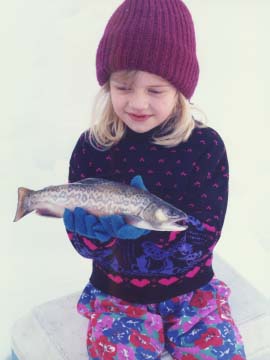
Safety has to be primary concern. Sunshine and mild air can be replaced by cold and storm in a hurry, particularly at higher elevations. Go prepared for anything. Dress in layers so you can easily adjust clothing for comfort. A hooded snowmobile suit over lighter clothing is a good choice.
It is critical to keep your feet warm and dry. Insulated, waterproof boots are a must for ice fishermen. Again, two layers of medium weight socks are usually better than a single, heavier sock.
Many ice fishermen invest in some kind of shelter to make their outings more comfortable. Shelters certainly aren't essential, but they are sure nice when the wind comes up. Basic shelters are just plastic or canvas windbreaks which anchor to the snow or ice. More elaborate tents and portable buildings are also available, along with heaters, chairs and other niceties.
Thin ice poses an extreme danger. Never venture out onto unknown ice without cautiously testing its strength and thickness. Drill a test hole close to shore, and then make other tests as you move out to your chosen spot. The strength of ice varies according to many factors, including age and purity. Generally, you can be confident that ice is safe if it is three or more inches thick. Don't risk unsafe ice — it's just not worth it.
There can be spots of soft ice on otherwise solidly frozen lakes, even during the coldest weather. Areas of moving water — produced by channels or springs — can produce very thin ice. Many reservoirs are being filled, so the thick ice floats away from shore and new ice forms. The result is often thin, hazardous ice near shore, with solid ice out a few feet. Be careful.
It's normal for ice to pop now and then as you walk on it. If it starts to break, spread out your weight by laying down. Then squirm or roll to safety.
All kinds of rigs are used to fish through the ice, but the most common are short rods designed just for ice fishing. They are fairly inexpensive and easy to handle. A lot of people just use an old spinning rod, but that is a bit awkward because the length of the rod forces you to stand back from your hole. Also, the small line-guides on the tip of most spinning rods tend to freeze shut.
"Tip-ups" are more convenient and useful when ice fishing, but are also more expensive. They come in a wide variety of designs. Basically, they use a frame which spans the hole, with a signal device above the ice and a spool of line under the water so it doesn't freeze. When a fish takes the hook it activates the signal to call the fisherman. Signal devices vary from spring loaded flags to alarms or lights.
A wide variety of baits are effective when ice fishing, depending on the kind of fish you are after. For trout, salmon eggs, power bait and worms are probably the most popular. Jigs and lures are also very effective, and are often used with bait. Ice flies tipped with eggs or worms can be deadly.
Mill worms or wax worms are popular with fishermen out after perch, bluegill or white bass. They are particularly effective when used in combination with a teardrop hook or some kind of jig. Use light tackle — four pound line works well. You generally don't want to use sinkers, and you want to use the smallest bobber available, so you can detect subtle strikes.
When you are ice fishing it is critical to locate an area right over fish. When you troll or cast in open water you can drag your hook across a lot of area, and it is likely to pass by a fish or two. But when you fish through a six or eight inch hole, your hook drops straight down and you only cover a couple feet of bottom. If you are a few feet away from the fish, you may never get a bite.
A fish finder really helps ice fishermen zero in on productive areas. There are several portable units on the market which can be used easily by ice fishermen. Most boat-mounted models can be made portable by putting them in a case which has an adjustable mount for the transducer, and powering them with a motorcycle battery. Some local tackle shops sell cases made just for that purpose. If the ice is clear you can shoot right through it — so you know if there are fish in the area even before you drill a hole. Clear snow off the ice and then dump a little water on top, so the transducer makes a good contact.
Any time you are using a fish finder, be sure the transducer is aimed straight down. Any variation will give inaccurate readings. Many portable units have a bubble level to make that easy.
Regardless of the time of year, you need to look for fish in areas which provide the oxygen, food and water temperatures they need. Often that means over weed beds or other structure, or near springs or inlets (be sure to watch for thin ice in those areas). When a reservoir is frozen trout often hover just off the bottom or just under the ice, but they may be found at any depth. Drop your hook to the bottom and then work your way up. Lift your rod a foot or so, then let your bait flutter down. Reel in a couple cranks and do it again. Fish will often strike as your bait is falling.
Watch what successful fishermen are using — and where they are fishing. Most will happily share their secrets.
If you don't catch fish in one area, move to another. Ten feet is often the difference between success and failure.
